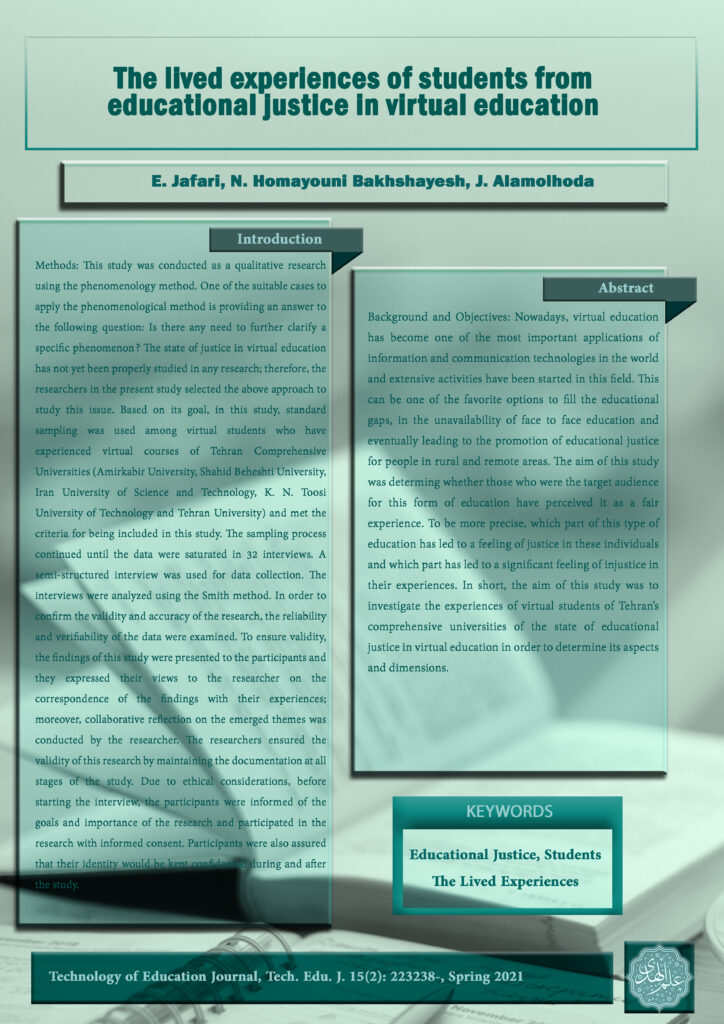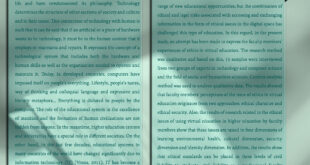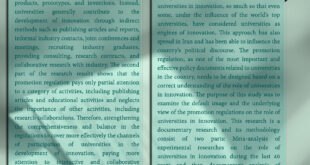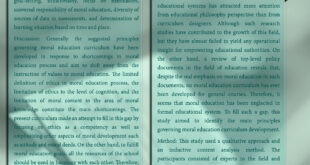The lived experiences of students from educational justice in virtual education
Jafari*, 1, N. Homayouni Bakhshayesh 1, J. Alamolhoda2
1 Department of Higher Education, Faculty of Education and Psychology, Shahid Beheshti University, Tehran, Iran
2 Department of Educational leadership and development, Faculty of Education and Psychology, Shahid Beheshti
University, Tehran, Iran
ABSTRACT
Nowadays, virtual education has become one of the most important
applications of information and communication technologies in the world and extensive activities
have been started in this field. This can be one of the favorite options to fill the educational gaps,
in the unavailability of face to face education and eventually leading to the promotion of
educational justice for people in rural and remote areas. The aim of this study was determing
whether those who were the target audience for this form of education have perceived it as a fair
experience. To be more precise, which part of this type of education has led to a feeling of justice
in these individuals and which part has led to a significant feeling of injustice in their experiences.
In short, the aim of this study was to investigate the experiences of virtual students of Tehran’s
comprehensive universities of the state of educational justice in virtual education in order to
determine its aspects and dimensions.
Methods: This study was conducted as a qualitative research using the phenomenology method.
One of the suitable cases to apply the phenomenological method is providing an answer to the
following question: Is there any need to further clarify a specific phenomenon? The state of
justice in virtual education has not yet been properly studied in any research; therefore, the
researchers in the present study selected the above approach to study this issue. Based on its
goal, in this study, standard sampling was used among virtual students who have experienced
virtual courses of Tehran Comprehensive Universities (Amirkabir University, Shahid Beheshti
University, Iran University of Science and Technology, K. N. Toosi University of Technology and
Tehran University) and met the criteria for being included in this study. The sampling process
continued until the data were saturated in 32 interviews. A semi-structured interview was used
for data collection. The interviews were analyzed using the Smith method. In order to confirm the
validity and accuracy of the research, the reliability and verifiability of the data were examined.
To ensure validity, the findings of this study were presented to the participants and they
expressed their views to the researcher on the correspondence of the findings with their
experiences; moreover, collaborative reflection on the emerged themes was conducted by the
researcher. The researchers ensured the validity of this research by maintaining the
documentation at all stages of the study. Due to ethical considerations, before starting the
interview, the participants were informed of the goals and importance of the research and
participated in the research with informed consent. Participants were also assured that their
identity would be kept confidential during and after the study.
Findings: The main question of this research was: What experiences do students have regarding
justice and injustice in virtual education? In analyzing the interviews, the main concepts were
extracted from the sentences expressed by the participants and were represented in a reduced
conceptual form, resulting in 153 descriptive codes. In the next step, by reflecting on the
descriptive codes, overlapping, similar, and related codes were identified. These concepts were
integrated in the form of 20 interpretive codes based on commonalities, similarities and semantic
overlaps. Finally, in the last step, the interpretive codes were reduced to 7 explanatory codes:
students’ equity with different characteristics (geographical condition, job status, and learning
competence), students’ equality in their interaction with professors (equality despite differences
in appearance features and cultures), lack of real interactions (short and fragile interactions),
content problems (non-practical content, lack of supervision in content development and lack of
codified and specific planning in presenting courses), organizational misconceptions toward
virtual students (having capitalistic attitude to students and not paying attention to students’ real
abilities), inequality in the use of facilities and costs (high educational costs and inequality in the
use of facilities), and inequality in providing educational services (lack of appropriate
organizational behavior patterns suitable for virtual teaching, low staff number to meet the
educational needs of students, high number of students in classrooms and the use of
inappropriate teachers for teaching).
Conclusion: Justice and its realization has always been one of the main slogans in the field of
education. Participants in the present study have sometimes focused on communication and
sometimes focused on the facilities provided in the training process. If we take a general look at
the themes obtained, we can divide them into two spectrums of justice and injustice although
more examples have been found in the section on injustice. Another main conclusion that is drawn
from the present study is the predominant link between the instances of justice and the inherent
characteristics of virtual education and the predominant link between the instances of injustice
in the way the virtual teaching is managed and lack of facilities appropriate for this form of
education. Finally, it should be noted that due to the increasing use of virtual education and its
fundamental difference from face-to-face education, ethical issues also appear differently in its
process which require accurate recognition and study.

To download the full article file, click on the link below “The lived experiences of students from educational justice in virtual education”
 Dr Jamilesadat Alamolhoda Personal Website
Dr Jamilesadat Alamolhoda Personal Website


